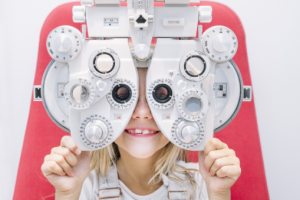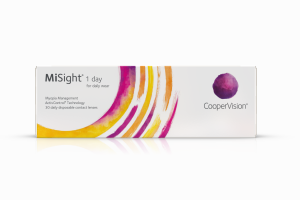You’ve likely heard the exciting news that CooperVision has received U.S. Food and Drug Administration (FDA) approval of its MiSight® 1 day contact lens[1], indicated to slow the progression of myopia (nearsightedness or short-sightedness) in children 8-12 years old at the initiation of treatment[2].
What you may not realize is that CooperVision’s commitment to and interest in myopia management goes far beyond a contact lens product. We’re seeking to support eye care practitioners like yourselves in providing the best outcomes for your young patients. One specific area in which we’re working is to develop a better understanding of how children’s activities can impact myopia change. As a first step, we’re seeking to understand what children, especially myopic children, do during their daily lives. In this article, we summarize a poster presentation[3], presented at the recent American Academy of Optometry meeting which examined the time spent in leisure and scholarly activities during the week and weekends by 108 children from Canada, UK, Portugal and Singapore wearing contact lenses over a 3-year period.
One interesting finding from this study was that the amount of time that children spent using mobile phones increased as the children aged (Figure 1). Additionally, the study found that in an average school week, children engaged in a wide variety of athletic activities including 40% in football, soccer or rugby; 37% dancing, gymnastics or martial arts; 35% skating or cycling; and 34% in swimming[4]. The frequency and time spent engaging in some activities remained relatively constant over the study period, (e.g. athletics) and decreased in others (e.g. swimming). In general, children reported spending more time watching television, playing video games, using a computer, playing with pets and shopping at weekends, and less time doing homework. There were also changes in how activities were split between weekends and weekdays as the children aged. For example, initially a higher proportion of children reported spending < 1 hour outdoors each day during the week than at weekends (45% versus 27%, p=0.002); however, this proportion was similar at the 3-year visit (28% versus 34%, p=0.459) (Figure 2).
Figure 1. Average Time Spent on Mobile Phone.
Figure 2. Average time spent outdoors.
In conclusion, this study found that the activities of school age children do change as they age. In particular, the study found that a larger proportion of children engaged in activities on mobile phones as they reached an older age, and that average amount of time spent outdoors stays consistent during weekdays but decreases during weekends as children age. Screen time (including mobile device use) has been hypothesized to potentially increase myopia progression, while time spent outdoors[5] is thought to be protective against myopia progression. Therefore, a better understanding of the behaviors of children, and how these behaviors change with time, is critical.
So what does all this mean for your practice?
The children in this study (ages 8–15 over study) reported engaging in a wide range of activities, many for which daily disposable contact lenses would offer clear advantages over spectacles. This highlights the potential for ECPs to fit more children with daily disposable contact lenses so that they can experience the benefits that they offer for sport and leisure activities.[6] Finally, since a high proportion of children reported swimming[7], it is important for ECPs to remember to instruct children to remove CLs prior to swimming and never let contact lenses come in contact with water. It’s also important to remember that this study looked at average behaviors among a cohort of 108 children of various ages. The types of activities and time spent pursuing them varied widely among some of the individual children so this suggests that it’s a good practice to better understand each specific child and their activities and motivations as a potential contact lens wearer.
To learn more about pediatric myopia and to sign up to receive updates about MiSight® commercial availability in the U.S., go to https://coopervision.com/practitioner/myopia-management
[1] Indications for use: MiSight® 1 day (omafilcon A) soft (hydrophilic) contact lenses for daily wear are indicated for the correction of myopic ametropia and for slowing the progression of myopia in children with non-diseased eyes, who at the initiation of treatment are 8-12 years of age and have a refraction of -0.75 to -4.00 diopters (spherical equivalent) with ≤ 0.75 diopters of astigmatism. The lens is to be discarded after each removal.
[2] Over a 3 year period, MiSight® 1 day reduced myopia progression on average by 59% compared to a single vision contact lens. Chamberlain P, et al. A 3-year randomized clinical trial of MiSight® lenses for myopia control. Optom Vis Sci. 2019; 96(8): 556-567.
[3] “Types and Patterns of Leisure and Scholarly Activity in Children Wearing Contact Lenses”. K. Dumbleton, E. Lumb. Fall 2019 American Academy of Optometry National Meeting.
[4] Warning: Water can harbor microorganisms that can lead to severe infection, vision loss or blindness. If the lenses have been submerged in water when swimming in pools, lakes or oceans, discard them and replace them with a new pair.
[5] Xiong, S., et al., Time spent in outdoor activities in relation to myopia prevention and control: a meta-analysis and systematic review. Acta Ophthalmol, 2017. 95(6): p. 551-566.
[6] Walline J et al. Benefits of contact lens wear for children and teens. Eye Contact Lens. 2007;33(6 Pt 1):317-21.
[7] Warning: Water can harbor microorganisms that can lead to severe infection, vision loss or blindness. If the lenses have been submerged in water when swimming in pools, lakes or oceans, discard them and replace them with a new pair.








